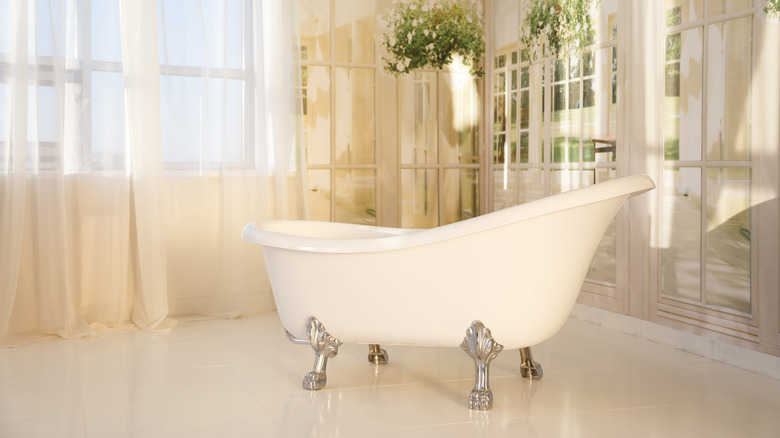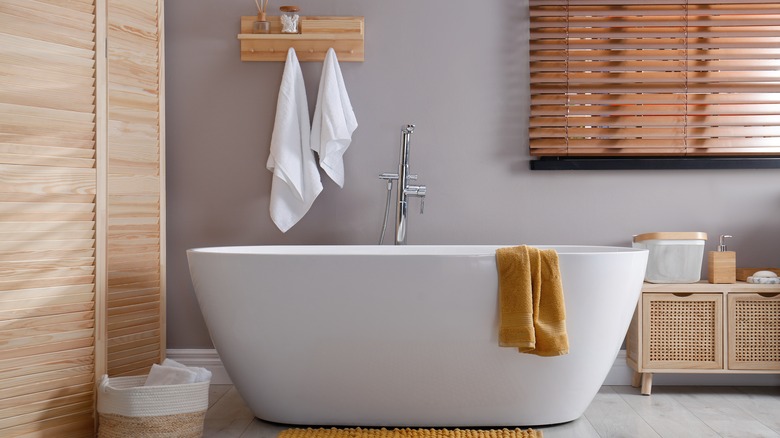Clawfoot Bathtubs Vs. Pedestal Bathtubs: What's The Difference?
Among the ways to unwind and relax after a long hectic day, soaking in a tub of water stands at the top of the list. And while the calming feeling of hot water is what invites us to it, studies have revealed some truly life-enhancing benefits of taking a bath. Byrdie explained how time spent in a bathtub can relieve muscle pains, elevate the mood, improve blood circulation and flow, and nourish the skin. Town & Country also discussed how a bath a day can help to burn calories, make the heart healthy, improve the quality of sleep and rest, and relieve symptoms of cold and flu.
But while these perks can motivate you to install a bathtub into your home, weighing your options and choosing the style or design of tub that meets your demands and expectations is a crucial step. To that end, in this article, we at House Digest will reveal to you the differences between the two most popular bathtub designs: clawfoot bathtubs and pedestal bathtubs.
How do clawfoot bathtubs differ from pedestal bathtubs in composition?
The primary differentiating factor between a clawfoot bathtub and a pedestal bathtub is their bottom style, literally. You see, the clawfoot bathtub is the timeless, vintage, four-legged bathtub, and the pedestal bathtub is similar to that but with a full round bottom, writes Kitchen Source. While they are both designed to sit away from a wall, the pedestal bathtub seems to do a little bit extra by coming in different configurations such as the wall mount and deck mount.
Additionally, the pedestal bathtub can come in a plethora of shapes from square to oval and more, as well as with multiple edge styles, as noted by HGTV. On the other hand, the clawfoot bathtub is just a single vintage style that you can always spice up with wine, candles, and roses — and it'll give you luxury.
Lastly, the clawfoot bathtub originally comes in cast iron, says Quality Bath; however, in modern times, it's stated to take after the pedestal bathtub which also comes in acrylic and other more light-weight materials.
What's the cost difference between clawfoot bathtubs and pedestal bathtubs?
Well, before we go into details, we feel obliged to tell you that vintage style impresses us a lot. However, even though this style is not modern, it tends to cost a lot. Did we just hint at the fact that clawfoot bathtubs are more expensive than pedestal bathtubs? Yes, we did. According to Lowes, the clawfoot bathtub, depending on its make and the material used, can cost anything between $2,000 to $5,000. That's more costly that the pedestal bathtub, which according to Vintage Tub can run you anything between $1,500 and $ 4,000.
However, the prices above are just for the purchase of the tubs; installation costs can differ. According to Inch Calculator, the labor costs for installation and plumbing are pegged between $450 and $900. And, if you require extras in your bathtub like jet streams and showers, you will be looking at an additional cost of anywhere from $300 to $1,000.
Pros and cons of clawfoot bathtubs
The first benefit of the clawfoot bathtub is that you get to place it anywhere, says Home Thangs. We also think you might be interested in the fact that the clawfoot bathtub enables you to take longer and more comfortable baths while feeling like you're at the height of luxury. Since you do not have to stand like you do in the shower, you can sit in the bath for hours (we did not intend to rhyme). Lastly, the plumbing for the clawfoot bathtub is iconic, which works perfectly with being in the center of the room.
On to the cons. We feel obliged to tell you that there is no platform to put your bath supplies on in clawfoot bathtubs. So, if you climb into the bathtub and you forgot your bathing oils, you have to climb back out. Other disadvantages include the fact that it's quite difficult for kids, the elderly, and people with disabilities to get in and out of the clawfoot bathtub, per Remodelista. Also, if you purchase a cast iron bathtub, you just may have a weight problem, especially if you don't live on the ground floor writes.
Pros and cons of pedestal bathtubs
For the pedestal bathtub, the pros include the designs you get to choose from. For one, there is a square, oval, or one-sided rise to it. Also, pedestal bathtubs are usually slightly larger than clawfoot bathtubs. Furthermore, they usually have either a rolled edge or a spread out edge, and this makes it possible for you to store your soap close by, writes The Bathtubber
On the flip side, you might be bothered by how heavy the freestanding pedestal bathtub can be. Seriously, think about it. The bathtub itself is heavy, then when you fill it with water, it gets heavier. Then, when you get in, jeez that is so much weight to think about! This might not be functional if you do not live on the ground floor, writes Houzz. Another con you may want to consider is that pedestal tubs are strictly meant for baths, so you don't get to enjoy the combo of a bath and shower with this bathtub setup.
Durability and maintenance of pedestal and clawfoot bathtubs
Ordinarily, any cast iron bathtub, be it clawfoot or pedestal, can last about 30 full years. However, in recent times, a bunch of other materials have been used to make bathtubs that cater to the weight issue. If you purchase any of those spin-offs, like acrylic, Long Home Products writes that you should be able to get about a good 10 to 15 years out of the material. However, this depends on how well you maintain the bathtub.
To keep your bathtub clean, you need to rinse off every part of it after use. But that is common knowledge, and we know you want all of the life hacks, so we have a few. Firstly, for the pedestal bathtub, you want to ensure that at installation, it should be properly caulked to the ground well to avoid water from seeping underneath. Cleaning underneath the clawfoot bathtub, on the other hand might get tricky, so HubPages suggests that you use long brushes to clean all the dust and scrub underneath when need be. For grime that settles in crevices, simply use dish soap and a sponge or toothbrush to get it all out, writes Molly Maid.
How do clawfoot bathtubs and pedestal bathtubs impact real estate value?
When we spoke about the differences between an alcove bath and a freestanding bathtub, we said that a installing freestanding bathtub means you will recoup at least 60% of your investment if you sell your home later. Well, we still stand on that.
Even better: According to Pure Wow, the decision to add a luxury-style bathtub such as a clawfoot bathtub can help you get 29% more than the initial asking price of your home. Now, this is not because the clawfoot bathtub is super sleek and modern — it's because a timeless vintage feel is always a luxury, and humans tend to pay more for that sense of luxury. The same thing applies to a pedestal bathtub since it falls among the category of freestanding bathtubs, which The Bathtubber claims will provide a significant return on its value.






